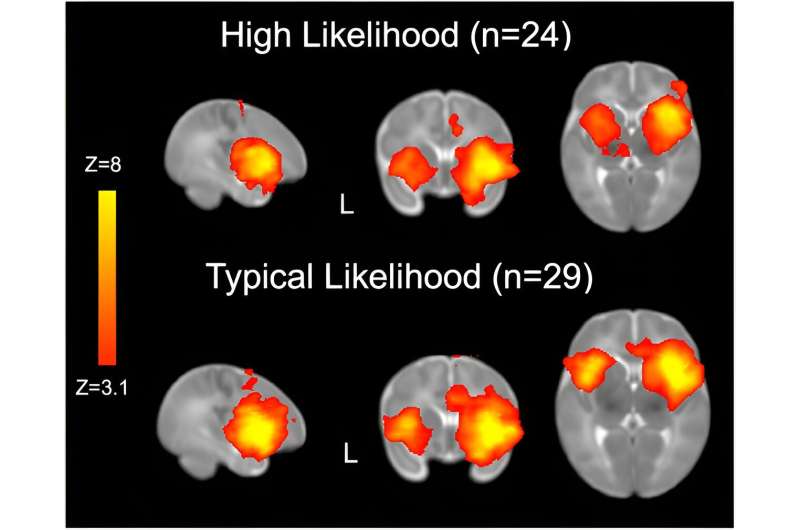This article has been reviewed according to Science X's editorial process and policies. Editors have highlighted the following attributes while ensuring the content's credibility:
fact-checked
peer-reviewed publication
trusted source
proofread
Study finds distinct brain connectivity patterns in infants at familial risk for autism

A study co-led by researchers at UCLA Health has found distinct brain connectivity patterns in six-week-old infants at risk for developing autism spectrum disorder (ASD). The authors say their findings suggest that differences in brain responses likely emerge much earlier than ASD-related behaviors can be identified, and also indicate that these brain patterns themselves may lead to the emergence of ASD-related behaviors by altering the brain changes that typically guide social development.
The results were published in Communications Biology.
The study prospectively evaluated 53 infants, 24 of whom had a higher likelihood of developing ASD due to having at least one older sibling with an ASD diagnosis while 29 had no family history of ASD or any other developmental disorders. Prior research has shown that the likelihood for developing ASD is approximately 20% in infants with a sibling with ASD.
The focus of the research was on the Salience Network, a collection of brain regions working together to detect and filter important stimuli from the environment and direct attention accordingly. The network plays a crucial role in identifying which stimuli are worthy of attention, thereby facilitating appropriate responses.
The researchers found that the high-likelihood infants showed stronger connections between the Salience Network and sensorimotor regions of the brain, areas involved in processing sensory information and movement. Meanwhile, the infants with a typical likelihood of developing ASD exhibited stronger connections between the Salience Network and prefrontal regions, which are crucial for social attention and interactions. In addition, infants with stronger connectivity to sensorimotor regions had weaker connectivity to prefrontal regions, suggesting that greater attention to basic sensory information comes at the expense of attention to socially relevant information.
Importantly, these early brain patterns seen at 6 weeks predicted behavior at age one year. Infants with greater connectivity with sensory regions showed great sensory over-responsivity at age one, an impairing condition that is common in autism whereby individuals show extreme responses to typical environmental sounds or sensations. In contrast, infants with more connectivity with social attention regions showed better ability to share attention with others at age one, an important precursor to developing the social and communication skills that are often impaired in autism.
The authors say these early brain connectivity patterns could help explain the reduced social attention and atypical sensory processing commonly seen in ASD.
"Although our modest sample size and the single timepoint for evaluating Salience Network connectivity are limitations in the current study, the overall results strongly suggest that atypical patterns of Salience Network connectivity may reflect a developmental vulnerability," they write. "This is a possibility that should be examined in large-scale longitudinal studies that heavily sample brain and behavioral measures during the first postnatal years."
"An emerging theory in autism research is that differences in sensory processing may precede the more classic social and communication symptoms of autism, and this data supports that theory in showing that very early brain differences related to how attention is allocated may predict both sensory and social behaviors in toddlers," said Shulamite Green, Ph.D., assistant professor at the David Geffen School of Medicine at UCLA and corresponding author.
"In other words, more attention to extraneous sensory stimuli in the environment could make it difficult to attend to social cues, and this difference in attention could really affect how the brain develops across the first year of life and beyond."
"What I find compelling about these converging findings in such young babies is that they provide both a mechanistic and theoretical account for the lack of the typical attentional biases for social stimuli seen in older infants and toddlers who later receive an ASD diagnosis," added Mirella Dapretto, Ph.D., co-author and associate director of the Semel Institute for Neuroscience and Human Behavior.
More information: Tawny Tsang et al, Salience network connectivity is altered in 6-week-old infants at heightened likelihood for developing autism, Communications Biology (2024). DOI: 10.1038/s42003-024-06016-9



















